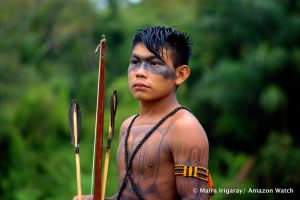
WALKER – To Keep a River Running
Robert Walker
Article first published online: 1 OCT 2016 Earth Island Journal
It came in low, guns bristling through the open bay. Such a strange apparition, like a giant insect, almost familiar but for its unnatural sound and fury and the faces staring down at them, striped in the black and green warpaint of the pariwat (outsider). With school in session, no one thought to ask about the unwelcome intrusion by radioing FUNAI, the Brazilian government’s agency for indigenous affairs.
As the shooting started it reminded some of carnaval firecrackers in Jacareacanga. But only for an instant. The Munduruku knew pariwat gunfire when they heard it, so they ran. The one young man not out hunting, Adenilson Munduruku, was killed by a bullet to the back of the head, execution-style. Could the Brazilian Armed Forces have mistaken Adenilson for an illegal gold miner as they hovered over a Munduruku village and gazed upon an indigenous culture engaged in its daily rituals? Any such explanation must be rejected given that a dozen people were injured in the November 2012 attack, children among them. One of the Munduruku villagers later told human rights activist Maíra Irigaray/Amazon Watch: “We knew immediately that this was intimidation because of our stand against the dams planned for Tapajós.”
Events have vindicated this interpretation, as the villagers have been forced to confront continuing efforts by Brazil to build a massive hydropower project in the Tapajós Valley, the Munduruku homeland. Tensions have persisted, particularly with Brazilian State agents trespassing on Munduruku territories seeking to develop a region over which the indigenous group claims sovereignty. Because this claim means nothing to the forces arrayed against them, the Munduruku have seen no choice but to resist. They know that development of the valley poses an existential threat to both the tribe and the forest.
Read the full publication at Earth Island Journal